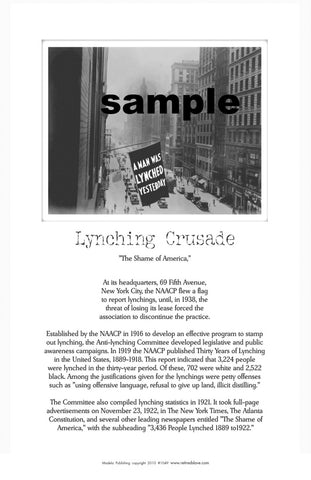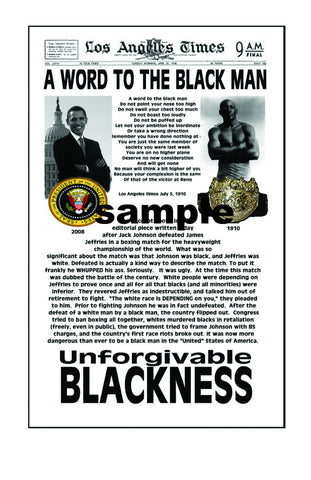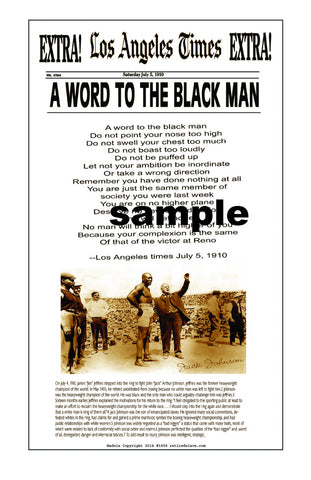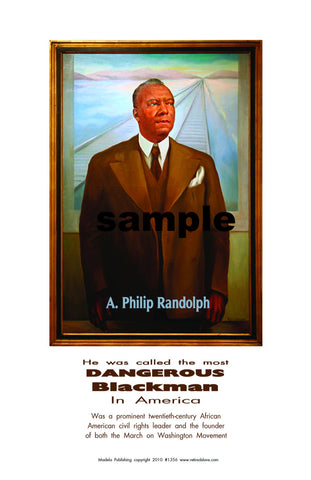Jim Crow System #1427
$ 8.00
Caption from poster__
Separate, but not equal
The Jim Crow System (Etiquette)
Jim Crow was the name of the racial segregation system, which
operated mostly in southern and border states, between 1877
and the mid-1960s. Jim Crow was more than a series of strict
anti-black laws. It was a way of life. Under Jim Crow, African
Americans were given the status of second-class citizens. Jim Crow
helped to make anti-black racism appear right. Many
Christian ministers taught that whites were the Chosen people,
blacks were cursed to be servants, and God supported racial
segregation. Many scientists and teachers at every educational
level, supported the belief that blacks were intellectually and
culturally inferior to whites. Pro-segregation politicians gave
persuasive speeches on the great danger of integration: the de-
struction of the purity of the white race. Newspaper and magazine
writers routinely referred to blacks as niggers, coons, and
darkies; and worse, their articles reinforced anti-black images
and ideas. Even children's games portrayed blacks as inferior
beings (see "From Hostility to Reverence: 100 Years of African-
American Imagery in Games"). All major organizations
reflected and supported the oppression of blacks. The Jim Crow
system was based on the following beliefs: whites were
superior to blacks in all important ways, including but not
limited to intelligence, morality, and civilized behavior;
relationships between blacks and whites would produce a
mongrel race which would destroy America; treating blacks
as equals would encourage interracial relation-ships between
men and women; any activity which suggested social equality
encouraged interracial sexual relations; if necessary, violence
must be used to keep blacks at the bottom racial level. The
following Jim Crow etiquette norms show how inclusive and
pervasive these norms were:
1. A black male could not offer his hand (to shake hands) with a
white male because it implied being socially equal.
Obviously, a black male could not offer his hand or any other
part of his body to a white woman, because he
risked being accused of rape.
2. Blacks and whites were not supposed to eat together. If they
did eat together, whites were to be served first, and some
sort of partition was to be placed between them.
3. Under no circumstance was a black male to offer to light the
cigarette of a white female--that gesture implied intimacy.
4. Blacks were not allowed to show public affection toward one
another in public, especially kissing, because it offended
whites.
5. Jim Crow etiquette required that blacks were introduced to
whites, never whites to blacks. For example: "Mr. Peters
(the white person), this is Charlie (the black person), that I
spoke to you about."
6. Whites did not use courtesy titles of respect when referring to
blacks, for example, Mr., Mrs., Miss., Sir, or Ma'am. Instead,
blacks were called by their first names. Blacks had to use
courtesy
titles when referring to whites, and were not allowed to call
them by their first names.
7. If a black person rode in a car driven by a white person, the
black person sat in the back seat or the back of a truck.
8. White motorists had the right-of-way at all intersections.
Jim Crow Guide, offered these simple rules
that blacks were supposed to observe in con-
versing with whites:
1. Never assert or even intimate that a white person is lying.
2. Never impute dishonorable intentions to a white person.
3. Never suggest that a white person is from an inferior class.
4. Never lay claim to, or overly demonstrate, superior know-
ledge or intelligence.
5. Never curse a white person.
6. Never laugh derisively at a white person.
7. Never comment upon the appearance of a white female.
Jim Crow etiquette operated together with Jim Crow laws (Black
Codes). When most people think of Jim Crow, they think of laws
(not the Jim Crow etiquette), which excluded blacks from public
transport and facilities, juries, jobs, and neighborhoods. The
passage of the 13th, 14th, and 15th Amendments to the Constitution
had granted blacks the same legal protections as whites. However,
after 1877, and the election of Republican Rutherford B. Hayes,
southern and border states began restricting the liberties of blacks.
Unfortunately for blacks, the Supreme Court helped to ignore the Con-
stitutional rights of blacks with the notorious Plessy v. Ferguson
(1896) case, which supported Jim Crow laws and the
Jim Crow way of life.
Print with Black Frames $25.00
For 24" x 36' Size prints
please call 678-608-7892 to order




